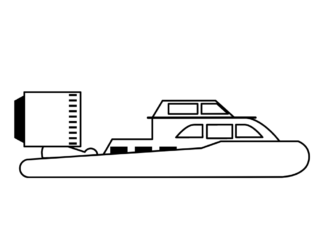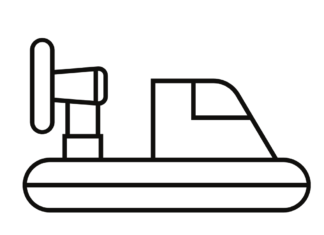This vehicle is constructed in a very interesting way. The air suction underneath the vehicle creates a cushion thanks to which the ship can float even a few centimetres above the water. If you haven't had the opportunity to see how it looks like, you can now see different coloring pages that we have prepared for you and color the picture of your choice.
Hovercraft Coloring Pages
Information
-
Definition:
A hovercraft is a vehicle capable of moving on both land and water thanks to a large air cushion created under its bottom. It is usually powered by reciprocating engines or turbines. -
Operating principle:
The hovercraft floats above the surface thanks to the powerful airflow generated by its engines, which fills a special skirt of flexible material placed at the bottom of the vehicle. -
History:
The concept of a hovercraft is old, but the first effective and practical models were designed in the 1950s. British Christopher Cockerell is considered the "father" of the modern hovercraft. -
Applications:
Hovercraft are used for a wide variety of purposes, from recreation and water sports to passenger transportation, military applications, and rescue operations, especially where traditional means of transportation are difficult to access. -
Hard-to-reach areas:
One of the main strengths of the hovercraft is its ability to navigate difficult terrain, such as marshes, sandy beaches, thin ice or flat waters. -
Ecology:
Although hovercraft can navigate delicate ecosystems such as wetlands, they do not cause as much damage in these environments as traditional propeller-driven boats. -
High speed:
Some modern hovercraft can reach speeds in excess of 80 km/h, making them an effective means of transportation over short distances. -
Various sizes:
There are various models of hovercraft, from small, one-person units to large vehicles capable of carrying hundreds of passengers. -
Construction:
A typical hovercraft design consists of a platform, engines (often two separate engines - one to generate the air cushion, the other for propulsion), a skirt, and rudders and other steering devices. -
Maintenance:
Like other vehicles, hoverboards require regular maintenance and inspection. Pay attention to the skirt, which is a key part of the vehicle and can become worn or damaged.
Trivia
-
First thoughts:
Although the first practical hoverboards appeared in the 1950s, the idea for a vehicle based on an airbag was patented as early as 1877 by Sir John Thorneycroft, a British engineer. -
Ferry crossings:
Hovercrafts were used as ferries between England and France across the English Channel. One of the most famous was the "Princess Margaret," which could carry 400 passengers and 60 cars. -
Hovercraft in rescue:
Because of their ability to navigate difficult terrain, hovercraft are often used in rescue operations, especially in flooded areas or swampy areas. -
The largest hovercraft:
The largest hovercraft is a Russian military vehicle called "Zubr," capable of carrying heavy equipment, including tanks. -
Hoverboard sports:
Hoverboards have become a popular means of transportation for motorsports enthusiasts. There are even racing competitions for hoverboards. -
Hovercraft in Antarctica:
Because of their ability to navigate on ice and open water, hovercraft have been used in research expeditions in Antarctica. -
Less noise:
Although hovercraft are quite loud, their noise is less harmful to aquatic fauna compared to traditional propeller-driven boats, which can disturb underwater life. -
Evolution in design:
The initial hovercraft models were large, clunky designs, but over the years they became more agile and aerodynamic, allowing them to increase their speed and maneuverability.






